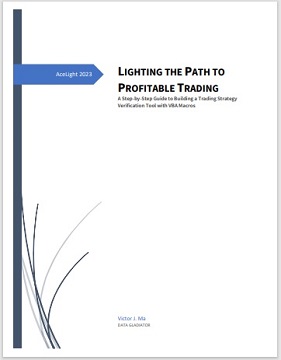Unlocking the Code: How to Optimize Stock Trading Strategies Backtesting Results
|
|
Many traders have spent countless hours perfecting their strategies, only to
find that they perform poorly in real-world situations. Stock trading can be
a lot like dating - it's easy to think you've found "the one" until you
realize you've been making terrible decisions all along. But fear not, my
dear traders! Just like with dating, backtesting can help you avoid making
costly mistakes in the future.
Stock trading strategies are a crucial
component of investment management, and backtesting is a crucial tool for
optimizing these strategies. Backtesting allows traders to simulate trading
strategies based on historical data and evaluate their performance. However,
the results of backtesting can be misleading if not analyzed carefully. Here
we have some suggestions:
1. Start with a clear hypothesis
Before
starting any backtesting, it's essential to have a clear hypothesis about
the trading strategy you want to test. This hypothesis should be based on
sound economic principles and should be grounded in past market behavior. A
clear hypothesis will make it easier to test the strategy and interpret the
results.
2. Use realistic assumptions
It's important to use
realistic assumptions when backtesting. Assumptions such as transaction
costs, slippage, and market impact can have a significant impact on the
performance of a trading strategy. If these assumptions are not realistic,
the results of backtesting can be misleading.
3. Use a large sample
size
Using a large sample size is important to ensure that the
backtesting results are statistically significant. A sample size of at least
10 years of historical data is recommended. Additionally, it's important to
use data from different market environments, such as bull and bear markets,
to ensure that the trading strategy is robust.
4. Validate the
results
It's important to validate the results of backtesting using
out-of-sample data. Out-of-sample data is data that was not used in the
backtesting process. This can help to determine whether the trading strategy
is robust and can perform well in different market environments.
5.
Monitor the strategy
Once a trading strategy has been developed and
backtested, it's important to monitor its performance in real-time. This can
help to identify any potential issues with the strategy and make adjustments
as necessary.
 For
more details,
Click
LIGHTING THE PATH TO PROFITABLE TRADING: A Step-by-Step Guide to Building a Trading Strategy Verification Tool with VBA Macros to get the whole tutorial handbook for free! For
more details,
Click
LIGHTING THE PATH TO PROFITABLE TRADING: A Step-by-Step Guide to Building a Trading Strategy Verification Tool with VBA Macros to get the whole tutorial handbook for free!
And click Free Trial to download strategies testing tools, all for a 30-day Free Trial.
Click on Subscription to order more strategies testing tools to help your stock trading.
Now we will discuss some other important issues:
A. Data quality is a
critical aspect of optimizing stock trading strategies backtesting results.
Backtesting is only as good as the data used to test the strategy, and if
the data is of poor quality, the results can be unreliable. Here are some
factors to consider when evaluating data quality for backtesting:
1.
Accuracy: The data used in backtesting should be accurate and error-free.
This includes accounting for any corporate actions, such as dividends, stock
splits, or mergers, that may affect the historical prices.
2.
Completeness: The data should include all necessary information required to
evaluate the trading strategy. This includes price data, volume data, and
any other relevant financial data.
3. Consistency: The data should be
consistent and standardized. Inconsistencies in the data can result in
inaccurate backtesting results.
4. Timeliness: The data should be
timely, meaning that it should be up-to-date and reflect the most recent
market conditions.
5. Relevance: The data used in backtesting should
be relevant to the trading strategy being tested. For example, if the
strategy focuses on large-cap stocks, using data for small-cap stocks would
not be relevant.
It's also essential to consider the source of the
data used in backtesting. Data from reputable sources, such as financial
data providers, is generally more reliable than data from less reputable
sources. Additionally, it's important to ensure that the data is properly
licensed and legally obtained.
B. Parameters is another critical
aspect of optimizing stock trading strategies backtesting results.
Backtesting parameters refer to the various settings used in the backtesting
process, such as the time frame, asset selection, and trading rules. Here
are some factors to consider when configuring backtesting parameters:
1. Time Frame: The time frame used for backtesting should be long enough
to capture a sufficient number of market cycles but not too long that it
becomes irrelevant to current market conditions. A time frame of 5-10 years
is generally considered appropriate for backtesting.
2. Asset
Selection: The assets selected for backtesting should be relevant to the
trading strategy being tested. For example, if the strategy focuses on
technology stocks, selecting assets in the energy sector would not be
relevant.
3. Trading Rules: The trading rules used in backtesting
should be consistent with the trading strategy being tested. For example, if
the strategy is a momentum-based strategy, the trading rules should be based
on momentum indicators such as moving averages or relative strength.
4. Risk Management: Proper risk management is critical to the success of any
trading strategy. The backtesting process should include parameters for risk
management, such as stop-loss orders, position sizing, and risk limits.
5. Trading Costs: Trading costs can significantly impact the performance
of a trading strategy. The backtesting process should include realistic
trading costs, including brokerage fees, slippage, and market impact.
It's important to note that backtesting parameters should be evaluated
and adjusted as necessary. Traders should regularly review the backtesting
results and adjust the parameters as needed to improve the strategy's
performance.
C. Data again. How to use data is another critical
aspect of optimizing stock trading strategies backtesting results.
Out-of-sample data refers to data that was not used in the initial
backtesting process but is instead used to test the trading strategy's
performance in a new, unseen market environment. Here are some factors to
consider when using out-of-sample data:
1. Importance of
Out-of-Sample Data: Using out-of-sample data is crucial because it provides
a way to test the trading strategy's performance in a new, unseen market
environment. This can help traders determine if the strategy is robust and
can perform well in different market conditions.
2. Splitting the
Data: To use out-of-sample data, the historical data should be split into
two parts: the in-sample data and the out-of-sample data. The in-sample data
is used to develop and optimize the trading strategy, while the
out-of-sample data is used to test the strategy's performance.
3.
Evaluation Metrics: Evaluation metrics should be chosen carefully when using
out-of-sample data. Common evaluation metrics include the Sharpe ratio, the
Sortino ratio, and the maximum drawdown. These metrics can help traders
determine the strategy's risk-adjusted performance and evaluate its
potential for future use.
4. Re-optimization: It's important to note
that re-optimizing the strategy using the out-of-sample data can lead to
overfitting and reduced performance in the future. Traders should avoid
making significant changes to the trading strategy based on the
out-of-sample data and instead use it to evaluate the strategy's robustness
and potential for future use.
5. Rolling Windows: Another approach to
using out-of-sample data is to use rolling windows, where the in-sample data
is updated periodically, and the out-of-sample data is used to test the
performance of the most recent version of the trading strategy.
Remember, folks, the key to successful backtesting is to think like a
detective - without the trench coat and fedora, of course. You want to
gather all the evidence, analyze it thoroughly, and avoid jumping to
conclusions. So, whether you're a seasoned trader or just starting out, use
these tips to optimize your backtesting results, and who knows - maybe one
day you'll be able to retire to a tropical island with a cocktail in one
hand and a stock ticker in the other. Just don't forget to invite us to the
party!
|


|

Free Tutorial
Share
|
|
|
|